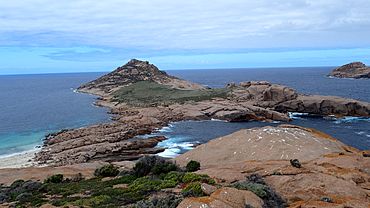Investigator Group Conservation Park facts for kids
.
Quick facts for kids Investigator Group Conservation ParkSouth Australia |
|
|---|---|
|
IUCN Category Ia (Strict Nature Reserve)
|
|

Looking at the 'Southern End' of Pearson Island
|
|
| Nearest town or city | Elliston |
| Established | 16 March 1967 |
| Abolished | 25 August 2011. |
| Area | 3.88 km2 (1.5 sq mi) |
| Managing authorities | Department of Environment and Natural Resources (2011) |
| See also | Protected areas of South Australia |
The Investigator Group Conservation Park was a special protected area in South Australia. It was located on several islands in the Investigator Group, off the west coast of the Eyre Peninsula. These islands are about 562 kilometers (350 miles) north-west of Adelaide and 50 kilometers (31 miles) south-west of Elliston. This park was created to protect the unique nature found on these islands.
What Was This Park?
The Investigator Group Conservation Park covered parts of several islands. These included Dorothee Island, Pearson Island, the Topgallant Islands, the Veteran Isles, and the Ward Islands. In 2010, the park was about 3.88 square kilometers (1.5 square miles) in size. It was a very strictly protected area, known as an IUCN Category Ia protected area. This means it was mainly for scientific research and protecting nature, with very little human disturbance allowed.
A Brief History of Its Protection
The land on these islands first became protected in 1967. They were set aside as "fauna conservation reserves" to protect animals.
- In 1972, these reserves officially became the Investigator Group Conservation Park. This happened under a law called the National Parks and Wildlife Act 1972.
- In 1980, the park was added to the Register of the National Estate. This list recognized places important to Australia's natural and cultural history.
- More land was added to the park in 1991 and 2002. This helped protect even more of the coastal areas.
- However, on August 25, 2011, the conservation park stopped existing. All its land became part of a new, even more protected area called the Investigator Group Wilderness Protection Area. This change made sure the islands would continue to be safe for wildlife.
Amazing Features of the Islands
The islands of the Investigator Group are truly special. They are like "island mountains" that rise steeply from the ocean. Some cliffs are as tall as 75 meters (246 feet)! You can also find deep overhangs, sea caves, and rocky slopes.
Some islands have soil, which allows plants to grow. You might see low shrubs like nitre bush, gallweed, and different types of saltbush. These plants are tough and can survive in the windy, salty island environment. Because it's hard to reach these islands, they have remained mostly untouched by people.
Wildlife of the Investigator Group
These islands are very important for many animals, especially birds and marine mammals.
Bird Life
Many birds use the Investigator Group islands for breeding and resting. Some rare or special birds found here include:
- Ospreys (a type of fishing hawk)
- White-bellied sea-eagles
- Cape Barren geese
- White-faced storm-petrels
- Short-tailed shearwaters
These islands might also be important stops for birds traveling between Flinders Island and the Australian mainland.
Marine Mammals
The islands are also home to some amazing marine mammals:
- A small group of Australian sea-lions lives and breeds on Ward Island. These are one of the rarest marine mammals in the world!
- Groups of New Zealand fur seals often rest on the rocky platforms of several islands. They might even breed there too.
These animals rely on the protected status of the islands to survive and thrive.


